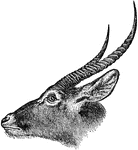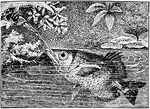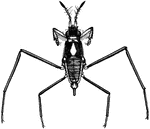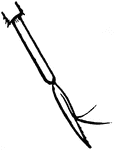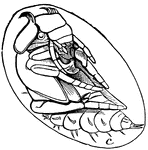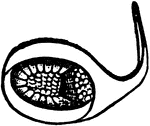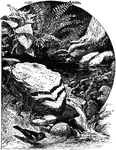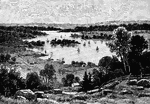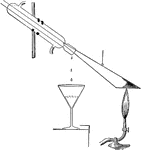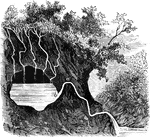
Periodical Spring
When the outlet tube of the reservoir is siphon-shaped, the discharge of the spring becomes periodical.…
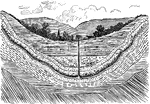
Artesian Well
Artesian Wells differ from ordinary wells in that their waters are discharged by natural pressures on…
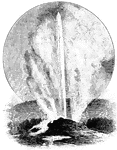
Geyser in Eruption
Geysers are boiling springs which, at intervals more or less regular, shoot out huge columns of water…
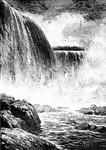
The Falls of Niagara
The grandest falls in the world are those of the Niagara, 160 feet high. Though greatly inferior to…
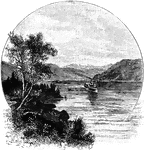
View of Lake George, N.Y.
Lake George, also known as Queen of American Lakes, is a long narrow lake at the southeast…
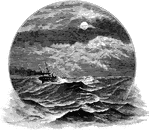
Ocean Wave
Waves are swimming motions of the water, caused by the action of the wind. Their height and velocity…

Capybara
The world's largest rodent, it has webbed feet and is usually in the water or along the shore of a river…
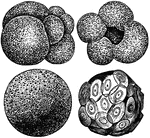
Foraminifera
These animalcule are so small that 1,000,000 are equal in bulk to only one cubic inch. They appear to…
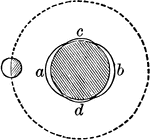
Lunar Tide
If the earth were uniformly covered with a layer of water, the passage of the moon over any place as…

Land and Sea Breezes
During the day the land near the coast becomes warmer than the sea. An ascending current, therefore,…

Archime' dean Screw
A cylinder with a triple threaded screw in a water tight case that revolves ater to the top for the…

Water Tiger
A water-tiger, Dytiscus marginalis species; male beetle, the elytra of the female at side.

Water Tiger
A water-tiger, Dytiscus marginalis species; anterior tarsus of the male, with sucking disks.

Water Scavenger Beetle
A water-scavenger, Hydrophilus triangularis species; structural detail of the adult.

Water Scavenger Beetle
A water-scavenger, Hydrophilus triangularis species; structural detail of the adult.

Water Scavenger Beetle
A water-scavenger, Hydrophilus triangularis species; structural detail of the adult.
Water Scavenger Beetle
A water-scavenger, Hydrophilus triangularis species; structural detail of the adult.

Whirligig Beetle Larva
The whirligig beetles are a family (Gyrinidae) of water beetles that normally live on the surface of…
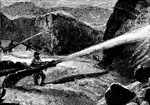
Washing
Men are breaking up the rocks with water so they can get to the silver or gold among the rocks.
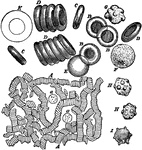
Red and White Blood Cells
Red and white corpuscles (cells) of the blood, magnified. Labels: A, moderately magnified, the red corpuscles…

Temperature Scales
Shows the differences between the Centigrade and absolute (Kelvin) temperature scales at the boiling…
!["If the two wires from a battery be placed in pure water, it will be foud tat practically no current passes...If a small quantity of sulphuric acid is added to the water, the solution is a good conductor. During the passage of current, bubbles form at the ends of the wires: at the positive electrode (anode)...oxygen appear[s]; at the negative electrode (cathode) there is a rapid evolution of hydrogen." -Brownlee 1907](https://etc.usf.edu/clipart/35400/35447/elec_35447_mth.gif)
Electrolysis
"If the two wires from a battery be placed in pure water, it will be foud tat practically no current…

Reduction of Copper Oxide
"When heated, hydrogen will combine with the oxygen of many oxides, forming water (steam) and the metal,…

Composition of Water
"If dry hydrogen is passed over a weighed quantity of copper oxide which is heated, steam and copper…
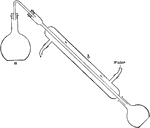
Distilling Apparatus
In order to rid water of impurities, it is required to boil water, then condense the steam to make it…

Sulphuric Acid Contract Process
Diagrammatic representation of the sulphuric acid contact process. "Sulphur, or ores containing sulphur,…
Nitrogen Preparation
"The bottle (a) serves as an aspirator to draw airthrough the apparatus and also to collect the residual…

Coal Gas Distillation
"Soft coal is heated in iron retorts at an intense heat. Moisture, volatile matter, and gases are driven…
!["Ammonia is a colorless gas with a peculiar odor, lighter than air, and exceedingly soluble in water...The great solubility of this gas is strikingly shown by the 'ammonia fountain.' A flask is filled with dry ammonia, and incerted over water. As soon as the [restraining] clip (not shown in picture) is removed from the ruber tubing, the water rushes in as the gas rapidly dissolves." -Brownlee 1907](https://etc.usf.edu/clipart/35400/35481/ammon_fount_35481_mth.gif)
Ammonia Fountain
"Ammonia is a colorless gas with a peculiar odor, lighter than air, and exceedingly soluble in water...The…

Refrigerating Plant
"In the manufacture of artificial ice, ammonia is liquefied by being compressed by powerful pumps; then…

Nitrous Oxide Preparation
An apparatus used to produce and capture nitrous oxide. A flask containing ammonium nitrate is heated,…
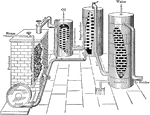
Water Gas Production
"The chief use of carbon monoxide is in water gas. This is produced by the reduction of steam by heated…
!["A verticle section of one form of blast-furnace is represented [here]. the crucible (C) is the part of the furnace in which the molten matte and slag collect. The body of the furnace consists of two concentric shells (cs), made either of wrought iron or of steel, between which cold water (W) is caused to circulate to precent the inner shell becoming heated...Pipes called tuyeres (T) enter the furnace a short distance above the hearth...Above the body of the furnace extend the hood (H) and the stack (S). A door (D), used in charging the furnace, is placed in the hood." -Brownlee 1907](https://etc.usf.edu/clipart/35400/35491/blast_fur_35491_mth.gif)
Blast-furnace
"A verticle section of one form of blast-furnace is represented [here]. the crucible (C) is the part…
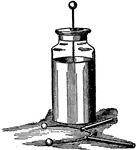
Leyden Jar
"The Leyden jar and discharger. Its discovery is attributed to the attempt of Musschenbrock and his…
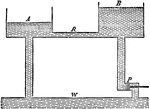
Analogy of Water Flow to Electric Current
"The water in resovoirs A and B stands at different heights. As long as this difference of level is…
Volta's Crown of Cups
"The metallic elements C and Z each conssted of two metals, the plate C being of copper and the plate…
!["Tyndall's experiment illustrating the production of heat by friction. The wheel is rotated and heat is produced [by friction] that heats the water in the end of the brass tube, which causes the water to boil, producing steam which pops off the cork." -Hawkins, 1917](https://etc.usf.edu/clipart/35600/35656/tyndall_35656_mth.gif)
Tyndall's Experiment
"Tyndall's experiment illustrating the production of heat by friction. The wheel is rotated and heat…
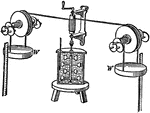
Joule's Experiment
"Joule's experiment on the mechanical equivalent of heat, in which he caused paddlewheels to rotate…

Edison-Lalande Cell
"...is constructed with a plate of black oxide of copper suspended between two plates of zinc, and the…
